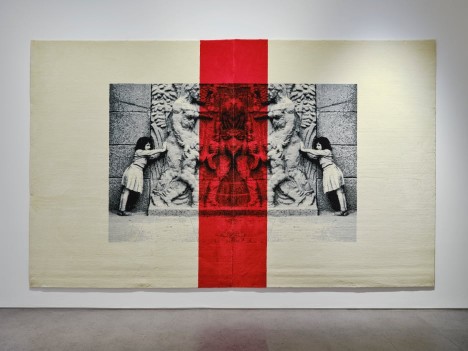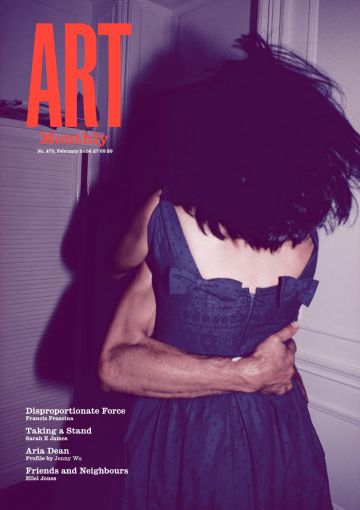Review
Self-Determination: A Global Perspective
Adam Hines-Green discovers connections in a timely exhibition of art from newly independent nations.

Gülsün Karamustafa, The Monument and the Child, 2010
In the aftermath of the First World War, new nations emerged. The Russian, Ottoman, German and Austro-Hungarian empires had collapsed. Millions had died and been displaced. The notion of ‘self-determination’ for people to form their own nations was deployed ahead of the 1919 Paris Peace Conference by Woodrow Wilson, and continued to reverberate in postwar international policy. Emerging from a three-year research project marking the centenary of the 1922 establishment of the Irish Free State, ‘Self-Determination: A Global Perspective’ juxtaposes this period in Irish history with the histories of other new nations, including Ukraine, Poland, Estonia, Latvia, Finland, Turkey and Egypt, exploring the role of the arts in the construction of these states. The exhibition is vast, featuring pieces from the interwar period alongside contemporary works, which include a series of commissions. It is also enormously ambitious. One fear for such an exhausting project is that it aims to be exhaustive. Another is that a global field of enquiry might overemphasise commonality and ignore local sociocultural circumstances. Instead, this is a kaleidoscopic exploration that follows connecting threads whilst also deep-diving into specifics, without ever crystallising into a grand narrative.
Of particular value in ‘Self-Determination’ is the sourcing of works rarely seen outside their countries of origin. Once juxtaposed with each other, the exchange of materials and the spread of modernist impulses begins to emerge. One room is devoted to a single German Expressionist play written in 1918, Gas, by Georg Kaiser, a story of social reconstruction in the wake of a gas plant explosion. The play became symbolic for many new nations and was staged extensively, including by the Berezil Group in Ukraine in 1923 as well as at the Gate Theatre in Dublin in 1930. In Estonian Kuno Veeber’s Blacksmiths, 1926, the angled musculature and anonymous polygonal faces are testament to Veeber having studied under the Cubist painter André Lhote in Paris in the mid 1920s. Elsewhere, the Ukrainian Zoia Bielkina’s Two Women, from the late 1920s, reveals the clear influence of Paul Gauguin and Henri Matisse, whose works she would only have accessed through photographic reproductions in magazines, books or newspapers. In an exhibition that is often heavy on information, there are also welcome moments of simple juxtaposition: three paintings of men on boats fishing, for example, one by Tymon Niesiełowski of Poland, another by Mirko Kujacic of Serbia, and finally Jack B Yeats of Ireland, where the viewer is invited to connect the dots.
If these lines of formal influence are persistently in the background, what the project foregrounds is the shared impetus for artists to concoct a visual language for the new nations. This is demonstrated at a range of scales. In one room, three watercolour designs for Latvian postage stamps by Ansis Cīrulis from 1917 sit in a glass case in front of a wall-sized image of Mahmoud Mokhtar’s Egypt Awakening, 1928, a key work in Egypt’s ‘Pharaonic Renaissance’. The work is a vast public sculpture of a woman partially unveiling herself as she leans against a sphinx. As is clear in ‘Self-Determination’, in imagining the new state, inspiration was often taken from the deep and mythic past. A sense of historic inevitability to the nation, its territory and its people was often concocted, though who was included in this concoction did not necessarily cover the entire population. In a section on architecture, the role of women overlooked in favour of their male partners is foregrounded, with work presented by the architects Eileen Gray and Aino Aalto, Irish and Finnish respectively. Elsewhere, in Estonian Lydia Mel’s Self Portrait (with tie), 1932, and in Latvian Aleksandra Beļcova’s Self-Portrait with a Picture of Austra Ozoliņa-Krauze in the Background, 1927–29, both women present themselves in masculinised and clearly politicised roles within domestic settings.
In one of the contemporary commissions, Minna Hendriksson draws directly on to the museum’s walls. Limits of the State, 2023, maps the legal strictures applied to women in both Ireland and Finland after independence, laws that restricted their roles to domestic and reproductive responsibilities. Jasmina Cibic’s Beacons, 2023, features a series of women recreating speeches given at a conference in Yugoslavia in 1985 for cultural workers from countries of the Non-Aligned Movement, re-emphasising the missing female voice in activities of world-building and self-determination. Many of the new commissions serve to demonstrate the continuing relevance of the actions taken in the aftermath of the First World War and, while this exhibition is dominated by historical works, the contemporary pieces confirm the persistent repercussions of this past on our present. The commissions are also of a very different temperature to the post-First World War works; amid paintings hot with rage, celebration or optimism, they tend to coolly reflect, conceptualise and complicate. At times, this offers welcome moments to pause, but it is a challenge for a viewer to do justice to lengthy audio-visual works in such an extensive exhibition.
Furthermore, it did not always feel necessary for a contemporary artist to expand further on the significance of the issues raised by the project. Wars continue to be fought over the defining characteristics of nations, including their territory, their values and their people. Ukraine is once again fighting for its independence. Dmytro Vlasiuk’s Dnieper Dam, 1923, depicts the washing away of traditional villages as part of the dam’s construction by the Soviet Union. Kherson Oblast, a neighbouring dam constructed in the years that followed, was blown up by Russia in June 2023, once again submerging local settlements. It is extraordinary that, despite the war, so many national treasures such as Vlasiuk’s Dnieper Dam from the National Art Museum of Ukraine in Kyiv could be loaned and transported to Dublin for this project. The remainder continue to be hidden in the west of the war-torn country, lying in wait as a testament to the creative acts that commemorate and construct nations.
‘Self-Determination: A Global Perspective’, IMMA, Dublin, 30 November 2023 to 21 April 2024
Adam Hines-Green is an artist and writer based in London.
First published in Art Monthly 473: February 2024.









